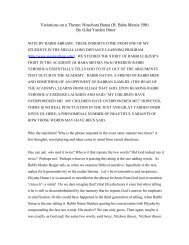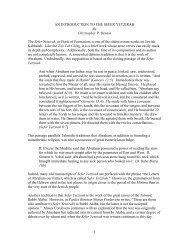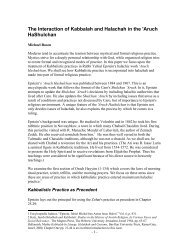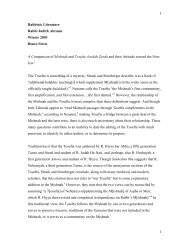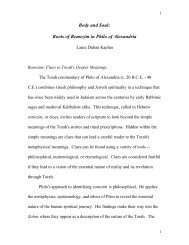The Symbolic Representation of the Sefer Torah - Maqom
The Symbolic Representation of the Sefer Torah - Maqom
The Symbolic Representation of the Sefer Torah - Maqom
Create successful ePaper yourself
Turn your PDF publications into a flip-book with our unique Google optimized e-Paper software.
practice to honor even children with <strong>the</strong> performance <strong>of</strong> this mitzvah, once <strong>the</strong>y have enough intelligenceto appreciate <strong>the</strong> concept <strong>of</strong> a form <strong>of</strong> sanctification. This serves to educate <strong>the</strong> children towards <strong>the</strong>observance <strong>of</strong> mitzvoth.” 52 <strong>The</strong> contemporary practice <strong>of</strong> glilah on <strong>the</strong> Sabbath was not done following <strong>the</strong>last portion <strong>of</strong> <strong>the</strong> reading (shivie) but ra<strong>the</strong>r after <strong>the</strong> maftir, <strong>the</strong>refore requiring an additional hagbahah tohonor <strong>the</strong> buyer. 53To accommodate all opinions, some communities lift <strong>the</strong> <strong>Torah</strong> and exhibit <strong>the</strong> <strong>Torah</strong> writing beforeand after <strong>the</strong> weekly readings. <strong>The</strong> Keter Shem Tob (p. 276 ff. 306) explains <strong>the</strong> reason for twiceperforming hagbahah is to allow <strong>the</strong> men and <strong>the</strong> women who missed <strong>the</strong> lifting during <strong>the</strong> removal <strong>of</strong> <strong>the</strong><strong>Torah</strong> from <strong>the</strong> Holy Ark to fulfill <strong>the</strong> mitzvah <strong>of</strong> seeing <strong>the</strong> <strong>Torah</strong>’s words. Rabbi Yosef (2000, p. 7, ff 13)reports this custom in <strong>the</strong> name <strong>of</strong> <strong>the</strong> Maharitz Doshinsky.When lifting <strong>the</strong> <strong>Torah</strong> scrolls to exhibit <strong>the</strong>m to <strong>the</strong> congregants, <strong>the</strong> lifter would rotate <strong>the</strong>m in alldirections. <strong>The</strong> Rabbinical authorities disagreed both on how to move one’s body and where <strong>the</strong> writingshould be exhibited, towards <strong>the</strong> roller or towards <strong>the</strong> lifter. <strong>The</strong> Shulkhan Arukh (Orakh Hayim 134:2)summarizes <strong>the</strong> debate and rules that “<strong>the</strong> face [writing] <strong>of</strong> <strong>Torah</strong> is exhibited to <strong>the</strong> congregants byshowing it to <strong>the</strong> people standing to his [<strong>the</strong> chazzan’s] right and his left, <strong>the</strong>n turns around for it is amitzvah upon all men and women to see <strong>the</strong> script and bow and recite ‘This is <strong>the</strong> <strong>Torah</strong> that Moses placedbefore <strong>the</strong> children <strong>of</strong> Israel, upon <strong>the</strong> command <strong>of</strong> G-d through Moses’ hand.” Rabbi Karo is basing hisruling on Tractate S<strong>of</strong>rim and many early Rabbinic authorities such as <strong>the</strong> Kol Bo, Machzor Vitri section527, <strong>the</strong> Or Zarua in laws <strong>of</strong> <strong>the</strong> Sabbath section 42 and <strong>the</strong> Tur Shulkhan Arukh section 147. <strong>The</strong>re arethose rabbinical authorities, such as Rabbi Chaim Benveniste (in his Sheyarei Kneset HaGedolah, OrakhHayim 134), who write that <strong>the</strong> lifter should remain in <strong>the</strong> same place but turn <strong>the</strong> <strong>Torah</strong> in variousdirections so that it can be viewed.<strong>The</strong> hagbahah ritual developed differently throughout <strong>the</strong> Jewish world as a result <strong>of</strong> eachcommunity’s social reality. Practices were motivated by <strong>the</strong> fear <strong>of</strong> dropping <strong>the</strong> <strong>Sefer</strong> <strong>Torah</strong>, <strong>the</strong> most52 <strong>The</strong> Hafetz Hayim is basing his ruling upon <strong>the</strong> Shaarei Efraim section 10 paragraph 22.53 I will not discuss <strong>the</strong> topic <strong>of</strong> gililah in this essay. My focus is on <strong>the</strong> rituals and customs that have direct influence upon <strong>the</strong>social behavior <strong>of</strong> <strong>the</strong> community. <strong>The</strong> same applies to <strong>the</strong> many o<strong>the</strong>r rituals involved with <strong>Sefer</strong> <strong>Torah</strong>.24



